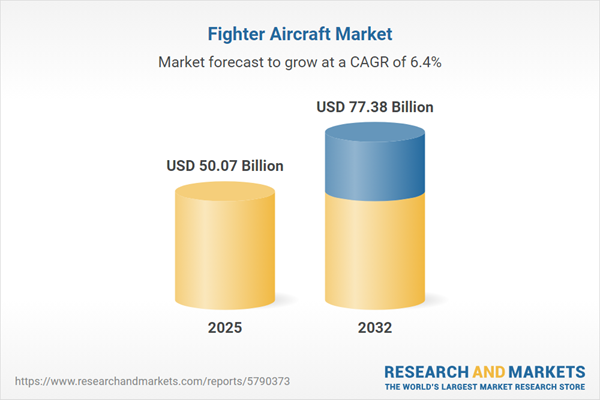Speak directly to the analyst to clarify any post sales queries you may have.
The fighter aircraft market is undergoing significant transformation as defense organizations worldwide reprioritize modernization, agility, and advanced capabilities. Senior decision-makers are pursuing solutions that deliver operational readiness and robust security in the face of rapidly evolving threats.
Market Snapshot: Growth and Opportunities in the Fighter Aircraft Market
In 2024, the fighter aircraft market is valued at USD 47.10 billion, with projections reaching USD 50.07 billion by 2025 and USD 77.38 billion in 2032. This steady trajectory reflects a compound annual growth rate of 6.40% across the forecast period. Investments are focused on fleet upgrades and the adoption of next-generation combat platforms, illustrating a global commitment to enhancing aerospace capabilities. Industry competitiveness is driven by technological innovation, shifting procurement strategies, and moves to secure supply chain resilience. The pressing need to replace aging fleets prompts organizations to recalibrate procurement methods to achieve mission resilience and maintain airspace security.
Scope & Segmentation: Strategic Dimensions of the Fighter Aircraft Market
- Role Types: Air superiority fighters offer advanced maneuverability and control; interception aircraft address quick-response threat scenarios; multi-role fighters support diverse operational needs; stealth variants minimize detection risks to optimize survivability.
- Platform Generations: Fourth-generation fighters deliver proven performance and reliability; enhanced 4.5-generation aircraft incorporate sophisticated electronics and agility; fifth-generation platforms enable advanced sensor integration and mission networking.
- Engine Configurations: Single-engine platforms prioritize streamlined maintenance and rapid deployment cycles; twin-engine aircraft support increased operational flexibility and endurance for longer missions.
- End User Applications: Air forces emphasize rapid response capabilities and sustained air dominance; naval organizations focus on carrier operability and effective integration within multi-domain defense operations.
- Manufacturer Presence: Organizations such as Boeing, Chengdu, Dassault, Lockheed Martin, and Sukhoi use global supply chains to drive innovation, production efficiency, and logistical strength.
- Regional Dynamics: The Americas, Europe, Middle East & Africa, and Asia-Pacific each reveal unique procurement patterns shaped by alliance strategies, in-country manufacturing capacities, and localized security imperatives.
- Key Participants: Leading contributors such as Lockheed Martin Corporation, The Boeing Company, United Aircraft Corporation, BAE Systems plc, Airbus SE, Dassault Aviation SA, Aviation Industry Corporation of China, Saab AB, Hindustan Aeronautics Limited, and Korea Aerospace Industries Co., Ltd. advance technology and foster strategic industry partnerships.
Key Takeaways for Senior Decision-Makers
- Stealth integration, modular open systems, and artificial intelligence applications support adaptive air combat and streamlined threat management across domains.
- The combination of manned and unmanned systems enhances intelligence gathering and ensures effective, real-time data exchange throughout mission execution.
- Strengthening end-to-end supply chain processes enables organizations to consistently deliver operational readiness when facing complex regulatory and market conditions.
- Digital transformation—including predictive maintenance and virtual design environments—speeds up modernization cycles and helps maintain platform reliability.
- Digital twin technologies improve lifecycle management by advancing operational efficiency and cost optimization for various airframe types.
- Investment in regional manufacturing and expanded partnerships not only drives technological leadership but also promotes knowledge transfer and economic competitiveness in defense procurement.
Tariff Impact: Navigating Policy-Driven Supply Chain Shifts
Recent U.S. policy changes are prompting defense organizations in the fighter aircraft segment to reevaluate supply chain strategies. By adopting local sourcing initiatives, diversifying suppliers, and increasing inventories, industry players aim to ensure uninterrupted production and adapt to new regulatory and acquisition frameworks while maintaining operational readiness.
Methodology & Data Sources
This report leverages both quantitative and qualitative insights from recognized defense procurement authorities and technology organizations. Findings are validated through peer-reviewed literature, expert interviews, and leading industry publications to guarantee thorough segmentation and actionable recommendations for stakeholders.
Why This Report Matters: Actionable Guidance for Senior Leaders
- Offers strategic guidance to align modernization initiatives with dynamic operational requirements and long-term mission objectives.
- Equips decision-makers with effective procurement and lifecycle management strategies to optimize overall fleet performance and readiness.
- Supports the development of resilient supply chains and robust industry partnerships to preserve competitiveness as conditions evolve.
Conclusion
This analysis delivers essential insights to help senior leaders drive informed resource planning, maximize fleet modernization, and uphold mission effectiveness in a swiftly adapting defense environment.
Additional Product Information:
- Purchase of this report includes 1 year online access with quarterly updates.
- This report can be updated on request. Please contact our Customer Experience team using the Ask a Question widget on our website.
Table of Contents
3. Executive Summary
4. Market Overview
7. Cumulative Impact of Artificial Intelligence 2025
Companies Mentioned
The companies profiled in this Fighter Aircraft market report include:- Lockheed Martin Corporation
- The Boeing Company
- United Aircraft Corporation
- BAE Systems plc
- Airbus SE
- Dassault Aviation SA
- Aviation Industry Corporation of China
- Saab AB
- Hindustan Aeronautics Limited
- Korea Aerospace Industries Co., Ltd.
Table Information
| Report Attribute | Details |
|---|---|
| No. of Pages | 190 |
| Published | October 2025 |
| Forecast Period | 2025 - 2032 |
| Estimated Market Value ( USD | $ 50.07 Billion |
| Forecasted Market Value ( USD | $ 77.38 Billion |
| Compound Annual Growth Rate | 6.4% |
| Regions Covered | Global |
| No. of Companies Mentioned | 11 |









